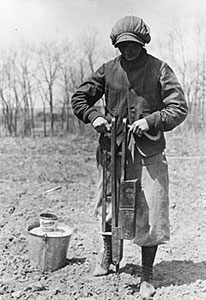
Nancy Hendrickson planting corn
SHSND# 0024-H-045Though gardening was well established by Hidatsa, Mandan, Arikara, and military gardeners by the 1870s, pioneers responding to the opportunities to acquire land and raise wheat seemed to re-invent gardening in their own interests. They learned the same lessons as military gardeners and the early seedsmen – that gardening in North Dakota must take place in an environment subject to wide ranges in temperature and moisture. Soil type was of less concern than early killing frosts and devastating drought.
Gardeners among the pioneers tend to diminish the importance of gardening. Good crops of wheat, especially on breaking, fulfilled their vision of their new life in Dakota. However, a few pioneers remember how important was a garden, their own or a generous neighbor’s, to their survival.
Among the pioneers’ memoirs, those written by Pauline Neher Diede stand out in regard to gardening. Two of her three memoirs, Homesteading on the Knife River Prairies and The Prairie Was Home, tell of the significance of garden produce to the pioneers. For the Nehers and their in-laws, the Martins, German-speaking immigrants from South Russia, America was entirely new. Even many of the garden vegetables were new to them. The Diedes and Martins quickly met earlier settlers in the Richardton area who had already established gardens. Usually they had two gardens, one for small vegetables. The other garden was the “bashtaan,” a garden for large and vine-growing vegetables such as potatoes, watermelons, and pumpkins (what other gardeners sometimes called a vine garden). Diede quoted her uncle Fred Martin as saying, “The good supply of stored vegetables in root cellars in the Richardton area made me hope I could provide as well for my family.” (Homesteading, p. 32)




